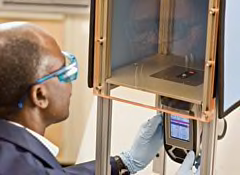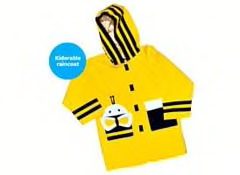Heavy metals
Despite progress, our tests still find products with lead and cadmium
Two years after sweeping rules sought to limit lead in children's products, another toxic heavy metal, cadmium, is causing concern. And though retailers and manufacturers are increasingly vigilant, lead continues to appear in some items.
Lead and cadmium have accounted for the recall of millions of products in the past few months alone. The list includes painted furniture, jewelry, children's clothing, McDonald's drinking glasses, and even trinkets that kids receive at doctors' and dentists' offices.
In our latest spot check of the marketplace and in our interviews and review of documents, Consumer Reports uncovered several worrisome findings:
No clear standards for cadmium
Even as companies intensify scrutiny of lead in products, cadmium is a newly recognized threat. In our tests, we found a hair barrette with a high level of total cadmium. Many other countries, including Sweden, have moved to limit cadmium in various products, but standards in the U.S. are just being drafted.
What's a children's product?
The nation's lead standard applies to items for children under 13. But if a product is not designed or intended primarily for children, it can contain more lead. We found a cell-phone charm with lead levels so high that it would be illegal if it were considered a children's product. The charm, which carries no age-related warning label, could appeal to those 12 or younger and is sold by Claire's, a store that caters to preteenagers as well as teenagers.
What stays on the shelves?
More oversight is needed of how lead-tainted products are pulled off store shelves. Our investigation turned up a children's vinyl raincoat with parts that exceeded legal lead limits for children's products. The company sells a reformulated version that contains only low or trace amounts of lead. But we were able to buy the original version late last year, after the deadline for removal of such products.
Concern over cadmium

Senior project leader Tunde Akinleye screens jewelry for lead and other toxic metals.
Cadmium is a carcinogen that is a byproduct of refining lead, zinc, copper, and other metals. One of its primary commercial uses has been in rechargeable batteries, such as those found in cordless phones and power tools.
Cadmium, like lead, could be turning up as a contaminant in consumer products imported from China in part because a cottage industry has developed there to melt down computer parts and other electronic waste. That process produces aggregate metals for items such as inexpensive jewelry, says David Carpenter, M.D., director of the Institute for Health and the Environment at the University at Albany, in New York. And although there are less-toxic alternatives, cadmium is also used as a pigment, a stabilizer in plastics, and a rust protectant for auto parts.
As this issue went to press, the Consumer Product Safety Commission was still working on regulations to limit the use of cadmium. Currently the CPSC says toys must comply with the limit of 75 parts per million (ppm) for soluble cadmium in surface coatings established by ASTM, an international organization that develops voluntary standards.
"We are working on a new specific limit for cadmium in children's products separate from the current limit in surface coatings for toys, and that's gone through independent scientific review," CPSC spokesman Scott Wolfson says. Sweden began limiting the use of cadmium in many products in the 1970s, and the European Union more recently set new rules.
Long-term exposure to cadmium has been linked to a host of adult health problems, including high blood pressure and age-related macular degeneration, as well as cancer of the lung, breast, and kidney. Children's developing bodies are especially vulnerable to damage from both lead and cadmium, but long-term exposure even at relatively low levels can be hazardous to anyone.
"Current research on cadmium's health effects is less than one–tenth of that for lead because lead was added to gasoline and paint before its ban and people never expected to see cadmium in consumer products like toys and jewelry," says Aimin Chen, an assistant professor at the University of Cincinnati College of Medicine who specializes in environmental and pediatric epidemiology. "But there is no question that adults and children should limit their exposure to both of these very toxic substances." The U.S. banned the use of lead in gasoline and house paint in the 1970s. Since a flood of lead-tainted toy recalls led to the Consumer Product Safety Improvement Act in 2008, it is illegal to manufacture or sell children's products that contain more than 300 ppm of total lead. Limits for lead in paint and surface coatings used on any consumer product are down to 90 ppm from 600 ppm. Lead still can be used legally in other ways in many other consumer products.
What we found

Our latest tests come four years after we began routinely checking consumer products for heavy metals. We examined a variety of children's products and household items that seemed likely to contain heavy metals, based on past recalls and our own previous tests. They included children's jewelry, metal barrettes, and vinyl children's products and window shades. We also screened items such as pens, sunglasses, and lipstick for lead, cadmium, and mercury, another toxic heavy metal.
Of the more than 30 products we tested using an initial screening method called X-ray fluorescence spectrophotometry (XRF), 14 showed relatively high levels. They were sent for further testing to an outside lab to determine total amounts of lead, cadmium, and mercury. Samples of three items were found to contain levels of heavy metals near or above regulatory limits or levels that could be hazardous under certain circumstances.
A green clover-shape cell-phone charm sold at the retailer Claire's caused the greatest concern. Some we tested contained levels exceeding 100,000 ppm of total lead. Given those levels, a child who accidentally swallowed a charm could be at risk for lead poisoning. Although the charm is not marketed specifically to children 12 and under, it could appeal to that age group or it could be accessible to them if a parent or older child has one.
Federal rules say that the 300-ppm lead limit applies to all children's products, which the 2008 law defines as "designed or intended primarily for children 12 years of age or younger." Similar questions of age might also arise with another item we tested, the Revlon Couture Hair Accessory, a barrette made of metal and decorated with small colored rhinestones. Samples of some tested positive for total cadmium at levels as high as 293,000 ppm, though potential for significant cadmium exposure through normal use is low. The barrette is not marketed to children but it could interest and be accessible to them.
The cadmium recalls announced this year were based on language in the Federal Hazardous Substances Act that prohibits the makers of children's products from using chemicals or metals in amounts that the CPSC considers "hazardous." But some manufacturers and retailers continue to argue that even if an item containing high lead levels might be appealing to preteenagers or is sold in stores popular with that age group, the product itself is not "intended primarily for children" and therefore does not violate the law.
It's up to the CPSC to determine whether such an item qualifies as a children's product, but it has not yet officially defined the criteria to be used in making that call. "CPSC is currently in the middle of federal rule making to define what is a children's product and establish the assessment criteria," Wolfson says.

Policing the stores

Even if a product is reformulated to eliminate contamination from lead, previous versions might remain on store shelves. That appears to have been the case based on what we found in our tests of some Kidorable raincoats with a bumblebee design and made of PVC plastic. That upscale garment is marketed for toddlers and preschoolers for $36. In December 2009 we purchased one raincoat at a New York area department store and another online through Amazon.com. We found lead levels that exceeded 1,000 ppm in most of the yellow parts of the coat that we tested, many times higher than the legal limit. And it's possible that some of that lead could be transferred to hands through repeated handling.
In January and May 2010 we purchased additional Kidorable bumblebee coats that carried labels saying "100% lead-free." Our tests showed that parts of those coats contained only low or trace levels of total lead, well below federal limits. Given the background levels of lead in the environment, it's nearly impossible for any product to live up to a "100% lead-free" claim, so finding those small amounts was not surprising.
Kidorable spokeswoman Christy Katzfey says the company reformulated its PVC products in late 2008 to comply with the new consumer product safety law and began using the lead-free labeling on its raincoats and backpacks in January 2009. In light of our findings, consumers shopping for Kidorable bumblebee raincoats should look for new coats with the "lead-free" label and take a pass on nonlabeled hand-me-downs or coats from yard sales.
Some assurances that products are lead free can be deceiving. Judy Braiman, president of Empire State Consumer Project, a nonprofit advocacy group in Rochester, N.Y., purchased a musical-note necklace at a local store in February 2010. The label accompanying the jewelry states that it is made in China and is "Lead Free." Yet testing showed the clasp on the necklace contained up to 912,000 ppm of total lead and that the pendant contained 288,000 ppm of cadmium. Those results came from the lab of Jeffrey Weidenhamer, a chemistry professor at Ashland University in Ohio, who alerted the CPSC. Weidenhamer said cadmium's presence in inexpensive jewelry is not new. He said his tests of more than 600 jewelry items from 2006 through May 2010 found almost 20 percent gave XRF readings of at least 10,000 ppm of cadmium.
Christine Canny, a Brooklyn entrepreneur who co-owns a jewelry business called FortuneKeeper that was launched in 2009, purchased beads and other components for her products from a Chinese supplier that marketed them as lead free. She had them tested at a lab and found beads that contained more than 235,000 ppm of lead. "We won't use the beads on our products, so they'll just sit in our office until we know how to safely get rid of them," Canny says. "Why is it so hard to make something that is safe?"
Recent notable recalls
| Recall date | Item recalled | Total number recalled | When & where sold | Type of heavy metal | Where manufactured |
|---|---|---|---|---|---|
| July 13, 2010 | Justice children's jewelry (necklaces, bracelets, and earrings) | 137,000 | Justice and Limited Too stores and online from November 2008 through February 2010 | Cadmium | China |
| June 30, 2010 | Children's Happy Charm bracelets and football rings | 66,200 bracelets and 2,200 rings | Distributed at doctors' and dentists' offices nationwide from June 2005 through March 2010 | Cadmium | China |
| June 17, 2010 | Children's belts | 105,150 | Target stores and Target.com from December 2008 through December 2009 | Lead | China |
| June 4, 2010 | "Shrek Forever After 3D" drinking glasses | 12 million | McDonald's from May 2010 through June 2010 | Cadmium | U.S. |
| April 7, 2010 | Decorative wood chests and tables | 7,000 | Major department and furniture retail stores from November 2001 through November 2009 | Lead in surface paint | China, Philippines, and Vietnam |
| April 1, 2010 | Bauer children's hockey sticks | 67,000 in U.S. and 60,000 in Canada | Sporting-goods stores nationwide from February 2005 through March 2010 | Lead in surface paint and decals | China |
Retailers make a move
In May 2010, after jewelry containing cadmium was reportedly found in Walmart stores, Wal-Mart said that it would voluntarily adopt European safety standards for cadmium and other heavy metals.
Wal-Mart says that it requires all mouthable components of many children's products be tested by CPSC-accredited labs and certified to meet a 75-ppm limit on soluble cadmium and various limits set for other heavy metals. Some states have imposed their own limits for lead or cadmium, which can cause confusion over labeling. For instance, Dream Dazzlers, a children's product containing a light-up magic wand, tiara, and earrings made for Toys "R" Us, carries a label warning that the product contains lead. That sounds alarming, but Toys "R" Us says it had to use the label because Illinois requires the warning if a product has more than 40 ppm of lead. But the item meets the federal limits for lead in toys.
What lies ahead
Standards for lead are expected to tighten further in August 2011, when limits for total lead in children's products drop to 100 ppm, if the CPSC determines it is technologically feasible to meet that more stringent standard. However, making products safer depends not only on imposing tough limits and testing requirements for contaminants such as heavy metals but also on oversight. The CPSC is still sorting out enforcement issues for certain aspects of the legislation, although it does respond to complaints.
The agency requires manufacturers or importers of children's products to submit samples of a product to an accredited third-party testing facility to ensure the item is within federal limits. And it tests children's products seized at ports, warehouses, and retail stores to ensure compliance with federal standards. If the items do not comply, it will investigate the manufacturer, the testing facility, and others in the supply chain.
Whether the agency has the proper staffing for such responsibilities remains to be seen. The CPSC currently has fewer than 20 staff members working directly with Customs and Border Protection inspectors and officials at the top 10 U.S. ports and in Washington.
Consumers Union, the nonprofit publisher of Consumer Reports, urges the CPSC to develop a regulation for cadmium limits for all children's products and believes that manufacturers, distributors, and retailers should thoroughly test for all heavy-metal concentrations before bringing products to market. The limits on lead are well defined for children's products, but lead and cadmium also should be regulated in products that can result in exposure via direct ingestion, such as cell-phone charms or garden hoses from which consumers might drink.
What you can do
- Consider do-it-yourself test kits, which can be useful though limited screening tools. Our September 2008 tests found that Homax Lead Check and Abotex Lead Inspector kits were somewhat reliable in detecting surface lead but were not good at detecting lead within a product.
- Don't allow children to have or play with cheap metal jewelry. If your children tend to put things in their mouths, add to that brass keys, barrettes, and charms.
- Take an inventory of your children's toys and check them against the recall list at www.cpsc.gov, which has photos and descriptions of products recalled for lead or cadmium. Also check the list if you're buying used items.
- Don't drink from garden hoses, which might contain lead that can leach into water. As a precaution, wash your hands immediately after handling power cords, extension cords, and even strings of holiday lights.
More From Consumer Reports
 WASHING MACHINE REVIEWS
WASHING MACHINE REVIEWSThe Best Matching Washers and Dryers These washer-dryer pairs cleaned up in Consumer Reports' tests.
 GENERATOR REVIEWS
GENERATOR REVIEWSHow to Pick the Right Size Generator for Your House Add up the items you need to power before making your choice.
Cars
 Build & Buy Car Buying Service
Build & Buy Car Buying Service
Save thousands off MSRP with upfront dealer pricing information and a transparent car buying experience.
Mobile
 Get Ratings on the go and compare
Get Ratings on the go and compare
while you shop




















